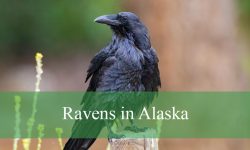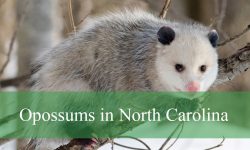If you’re a birdwatcher who loves exploring different states, Montana offers a fascinating variety of black and white birds that are both striking and unique. The vast landscapes, from mountains to wetlands, provide perfect habitats for many species with bold contrasting colors. Observing these black and white birds in Montana is a rewarding experience for anyone passionate about birding.
Black and white birds in Montana stand out with their distinctive plumage patterns that make identification easier and more exciting. From the clever Black-billed Magpie to the elusive Black-backed Woodpecker, each species has its own charm and story. This diversity adds a special touch to birdwatching trips across Montana’s varied environments.
In this article, you’ll find pictures and detailed identification tips for 22 black and white birds commonly found in Montana. For both seasoned birders and beginners, these species highlight the beauty and complexity of Montana’s avian world. Get ready to add some striking black and white birds to your Montana birding checklist!
Common Black and White Birds Found in Montana
Black-billed Magpie
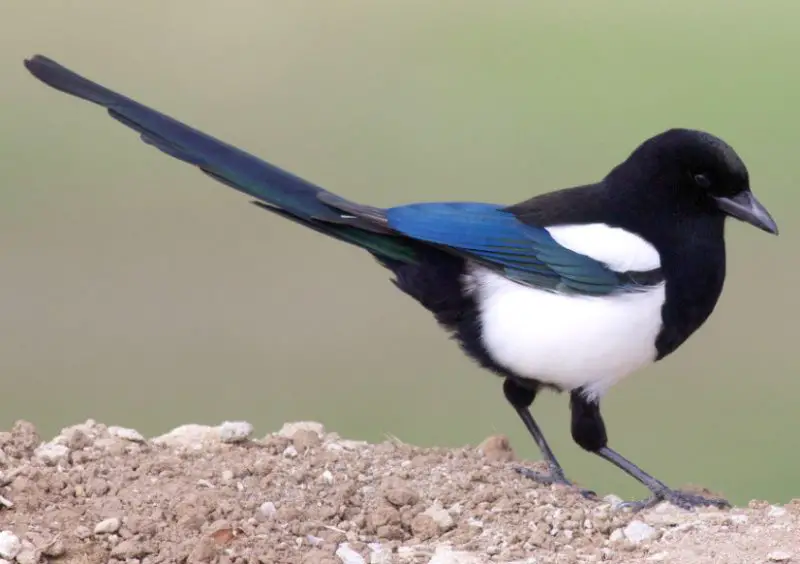
The Black-billed Magpie is a striking and easily recognizable bird, known for its long, graceful tail and bold black-and-white plumage. It has a glossy black head, chest, and back, contrasting sharply with bright white patches on its wings and belly. One of its most distinctive features is the iridescent blue-green sheen on its tail feathers, which shimmer in the sunlight. This bird typically measures about 17 to 18 inches (43 to 46 cm) in length, making it one of the larger members of the crow family. Its sharp, intelligent eyes and loud, varied vocalizations add to its unmistakable presence in the Montana landscape.
In Montana, Black-billed Magpies are common across a wide variety of habitats, including open grasslands, agricultural fields, shrublands, and urban areas. They are highly adaptable birds and often thrive near human settlements, where they take advantage of food sources like garbage, roadkill, and bird feeders. Magpies are well known for their social behavior, often seen in pairs or small groups, and they are notable for their complex calls and ability to mimic sounds. Their territorial displays and playful antics make them a favorite among birdwatchers.
Black-billed Magpies have a diverse diet that reflects their opportunistic nature. They feed on insects, small rodents, eggs, and nestlings of other birds, as well as carrion and plant material such as seeds and berries. Their diet often changes seasonally, with more animal prey consumed in spring and summer, and more plant matter in fall and winter. This varied diet helps them survive the often harsh Montana winters and take advantage of the region’s seasonal food availability.
Black-capped Chickadee

The Black-capped Chickadee is a small, energetic bird that is easily recognized by its distinctive black cap and bib, which contrast vividly against its white cheeks. Its back is a soft gray color, and its underparts are a pale buff or whitish hue. Measuring approximately 4.7 to 5.9 inches (12 to 15 cm) in length, this bird is known not only for its charming appearance but also for its lively personality. The chickadee’s famous “chick-a-dee-dee-dee” call is one of the most recognizable bird sounds in North America and is used both for communication and as an alarm signal.
In Montana, Black-capped Chickadees are widespread and year-round residents found in a variety of habitats, including mixed and deciduous forests, suburban parks, and wooded residential areas. They prefer areas with dense trees and shrubs, which provide both shelter and nesting sites. These birds are highly adaptable and often form small flocks in winter, banding together for warmth and foraging efficiency. Their fearless and inquisitive nature makes them frequent visitors at backyard feeders.
The diet of the Black-capped Chickadee shifts with the seasons. During the warmer months, they primarily feed on insects, spiders, and caterpillars, foraging actively by gleaning from leaves, branches, and tree bark. In winter, when insects are scarce, chickadees switch to seeds and berries, and they often cache food to retrieve later. Their ability to store food combined with their agile foraging behavior helps them endure Montana’s cold winters successfully.
Dark-eyed Junco
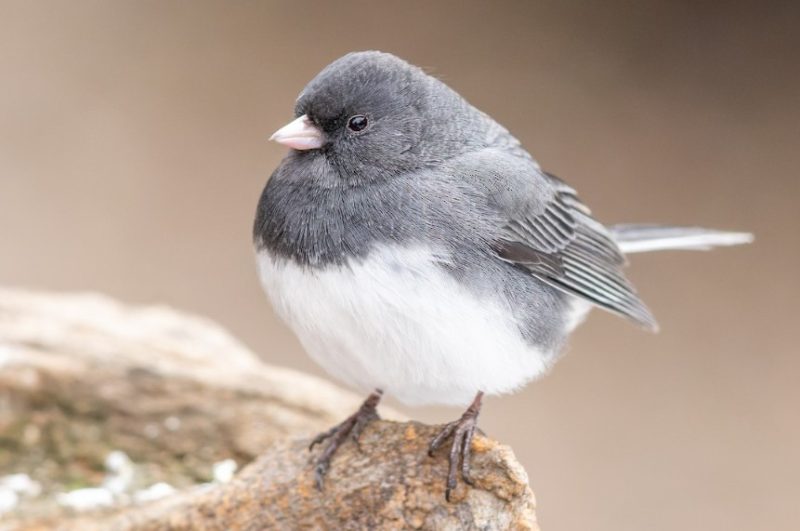
The Dark-eyed Junco is a small, sparrow-like bird that is a familiar sight across Montana, especially during the colder months. It measures about 5 to 6.5 inches (13 to 16.5 cm) in length and features a soft slate-gray or brownish coloration on its upperparts with a clean white belly. The head is typically darker, often slate-gray or brown, depending on the subspecies, and many have pinkish or pale bills. Montana hosts several subspecies of Dark-eyed Junco, with the “Oregon” and “Slate-colored” variants being the most common.
Dark-eyed Juncos are widespread throughout Montana, appearing in forests, woodlands, open fields, and even suburban backyards. They are ground foragers and are often seen hopping and scratching through leaf litter or snow in search of food. During the breeding season, they prefer coniferous or mixed forests where they build their nests on or near the ground, hidden beneath dense vegetation.
Their diet consists mainly of seeds, especially during winter, when they rely on grasses, weeds, and fallen seeds on the ground. In warmer months, insects and other small invertebrates become an important part of their diet, providing necessary protein for raising young. Dark-eyed Juncos are frequent visitors to bird feeders in Montana, where they particularly enjoy millet and sunflower seeds. Their soft, trilling songs and distinctive flight patterns make them a favorite among bird enthusiasts.
White-breasted Nuthatch

The White-breasted Nuthatch is a small, agile bird measuring about 5 to 6 inches (13 to 15 cm) in length, recognized by its distinctive white face, throat, and underparts. Its upperparts are a muted blue-gray color, and it sports a black cap and nape that contrast sharply with its white cheeks. One of the most fascinating behaviors of this species is its ability to move headfirst down tree trunks and branches as it forages, a unique trait among many woodland birds.
This nuthatch is commonly found in Montana’s mature deciduous and mixed forests, as well as suburban parks and wooded residential areas. It prefers wooded habitats with large trees, which provide ample foraging opportunities and nesting sites. White-breasted Nuthatches are non-migratory and remain in Montana year-round, adapting well to a variety of forest types and climatic conditions.
The White-breasted Nuthatch feeds primarily on insects, spiders, and other small invertebrates found on tree bark. It uses its strong bill to probe crevices and peel back bark to uncover hidden prey. During the colder months, it supplements its diet with seeds and nuts, often storing these in bark crevices for later consumption. This bird also readily visits backyard feeders, especially those offering suet, sunflower seeds, and peanuts, making it a familiar and welcome visitor in Montana gardens.
Downy Woodpecker
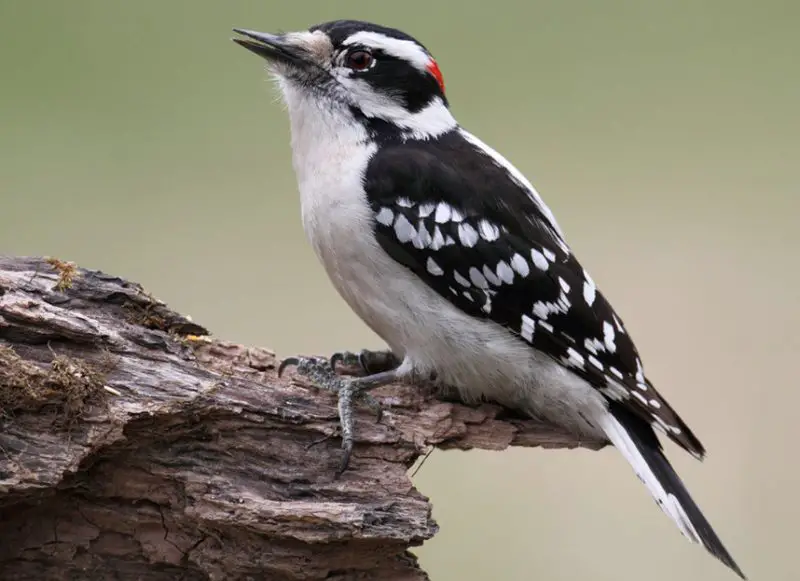
The Downy Woodpecker is the smallest woodpecker found in Montana, measuring about 6 to 7 inches (15 to 18 cm) in length. It has a distinctive black-and-white plumage, with a black-and-white striped head, a white back, and black wings speckled with white spots. Male Downy Woodpeckers are distinguished by a small red patch on the back of their heads, while females lack this marking. Its relatively short bill sets it apart from the similar but larger Hairy Woodpecker.
This species is widespread across Montana and occupies a variety of habitats, including forests, woodlands, orchards, and suburban neighborhoods with mature trees. Downy Woodpeckers are year-round residents in the state and are frequently seen clinging to tree trunks and branches as they search for food. Their persistent drumming and tapping are often heard in wooded areas during the breeding season.
Downy Woodpeckers primarily feed on insects such as beetle larvae, ants, and caterpillars, which they extract from bark crevices using their sharp bills. In winter, when insects are scarce, they shift their diet to include seeds and berries. They are common visitors at backyard feeders, especially those offering suet and sunflower seeds. Their presence in both wild and suburban areas makes them a favorite species for Montana birdwatchers.
Northern Mockingbird
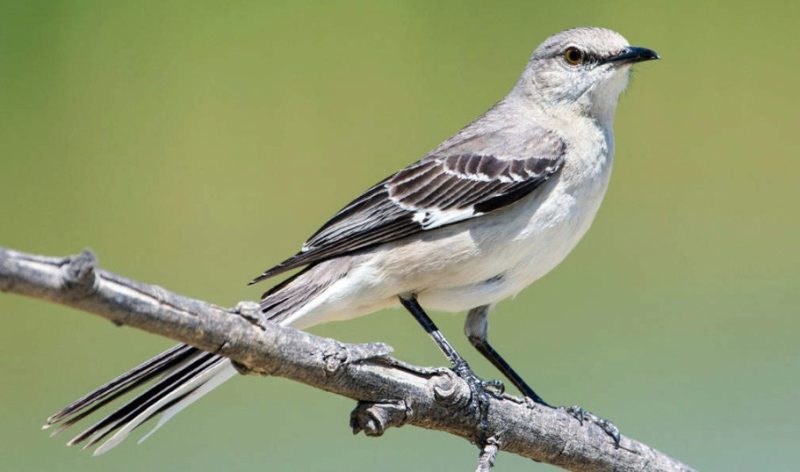
The Northern Mockingbird is a medium-sized songbird, about 8 to 10 inches (20 to 25 cm) in length, known for its striking gray plumage and white wing patches visible during flight. It has a slender body, long tail, and pale underparts, with a sharp, slightly curved bill. This bird is famed for its impressive vocal ability, able to mimic the songs of other birds, insects, and even mechanical noises, often repeating phrases multiple times. Its varied and complex song repertoire makes it one of the most talented mimics in North America.
In Montana, Northern Mockingbirds inhabit open areas such as shrublands, farmland edges, suburban yards, and parks. They prefer habitats with scattered trees or shrubs, which provide ideal perches for singing and vantage points to watch for insects. While not as common as in some southern states, mockingbirds are found mainly in the southern and eastern parts of Montana during the breeding season, and they occasionally appear as migrants or winter visitors in other areas.
The Northern Mockingbird’s diet is highly varied and includes insects, spiders, berries, and fruits. During spring and summer, they primarily consume insects such as beetles, ants, and grasshoppers, which provide protein needed for breeding. In fall and winter, their diet shifts toward fruits and berries, such as elderberries and mulberries. Their ability to adapt their diet helps them thrive in a range of environments across Montana.
Hairy Woodpecker

The Hairy Woodpecker is a medium-sized woodpecker, measuring around 9 to 10 inches (23 to 26 cm) in length, characterized by its black-and-white plumage and relatively long bill compared to the Downy Woodpecker. It has a white underside, black wings with white spots, and a white back stripe. Males have a small red patch on the back of their heads, while females do not. The Hairy Woodpecker’s larger size and longer bill help distinguish it from the similar but smaller Downy Woodpecker.
Hairy Woodpeckers are widespread across Montana, frequenting mature forests, woodlands, orchards, and suburban areas with large trees. They prefer areas with a good supply of dead or decaying trees, which are crucial for nesting and foraging. They are year-round residents and are often seen clinging vertically to tree trunks and branches, using their strong bills to probe for insects beneath bark.
Their diet mainly consists of insects, including beetle larvae, ants, and wood-boring insects found under tree bark. They also eat fruits and nuts occasionally. Hairy Woodpeckers forage by hammering and chiseling into wood to uncover insect prey, and they sometimes visit suet feeders in backyards. Their persistent drumming and distinctive call add life to Montana’s forested areas.
Loggerhead Shrike
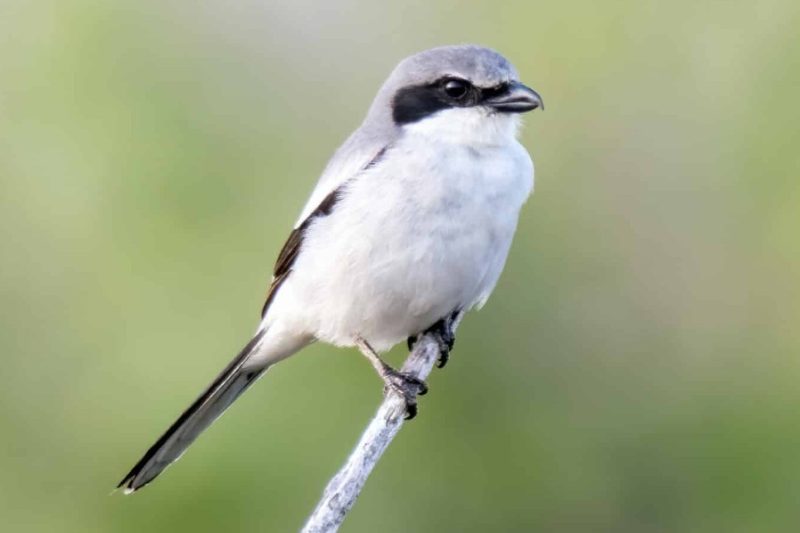
The Loggerhead Shrike is a medium-sized songbird, about 9 inches (23 cm) long, notable for its bold black, white, and gray plumage and its hooked, raptor-like bill. It has a gray body with a black mask across its eyes and black wings with white patches. This bird is often called the “butcher bird” because of its unusual hunting behavior: it impales prey on thorns or barbed wire to store or tear it apart. The Loggerhead Shrike’s sharp eyesight and aggressive hunting style set it apart from many songbirds.
In Montana, Loggerhead Shrikes inhabit open grasslands, shrublands, and agricultural areas with scattered shrubs or fences, which provide ideal hunting perches. They are primarily found in the eastern and central regions of the state and prefer habitats with plenty of open space for spotting prey. Shrikes are territorial and often seen perched conspicuously on fences or telephone wires as they scan for insects, small birds, or mammals.
Their diet is carnivorous and varied, including insects like grasshoppers and beetles, small birds, rodents, and reptiles. The Loggerhead Shrike’s habit of impaling prey is unique among songbirds and helps it manage larger prey items that it cannot swallow whole. This fascinating behavior, combined with its striking appearance, makes the Loggerhead Shrike a compelling bird to observe in Montana.
Northern Shrike
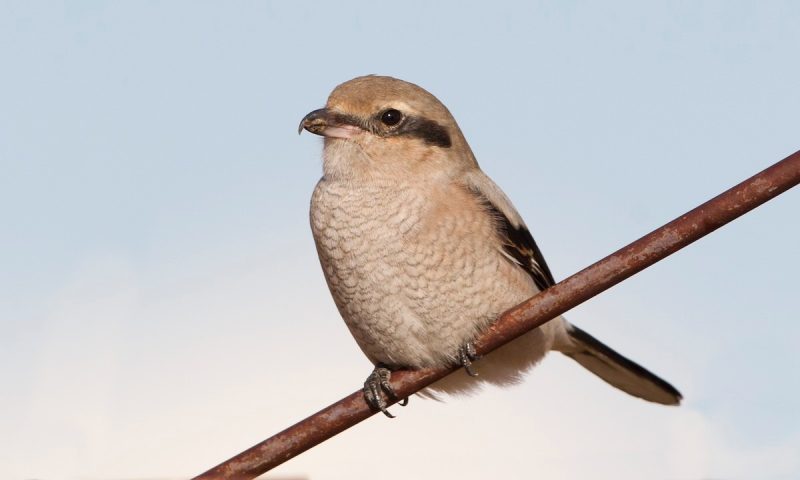
The Northern Shrike is a medium-sized predatory songbird, measuring about 9 to 10 inches (23 to 25 cm) in length. It is mostly gray with a white underside and black wings marked with white patches. It also has a distinct black mask that extends through the eyes, and a slightly hooked bill used for catching and killing prey. This bird is known for its predatory habits and is sometimes called the “butcher bird,” similar to the Loggerhead Shrike, due to its habit of impaling prey.
Northern Shrikes breed in the northern tundra and boreal forests but migrate south into Montana during the winter months. In Montana, they are usually found in open habitats such as grasslands, shrublands, and forest edges, especially during winter. They favor areas with scattered trees or shrubs for hunting perches and use their keen eyesight to spot prey from a distance.
Their diet consists mostly of insects, small birds, mammals, and occasionally reptiles. The Northern Shrike captures prey with its sharp bill and uses its talon-like feet to hold it. It impales larger prey on thorns or barbed wire, similar to the Loggerhead Shrike. This bird’s combination of raptor-like hunting skills and songbird appearance makes it an intriguing species to watch during Montana’s colder months.
Black-and-White Warbler
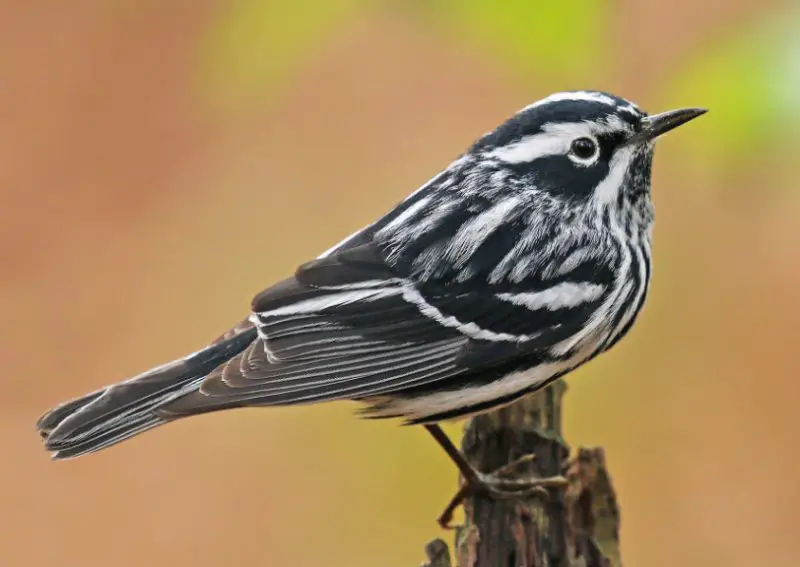
The Black-and-White Warbler is a small songbird, measuring about 4.3 to 5.1 inches (11 to 13 cm) in length, known for its distinctive black-and-white striped plumage. Unlike many warblers that forage in the canopy, the Black-and-White Warbler creeps along tree trunks and branches like a nuthatch, using its curved bill to probe for insects. Its bold black-and-white pattern provides excellent camouflage on the bark of trees.
In Montana, the Black-and-White Warbler is a migratory species, usually passing through or breeding in mixed and deciduous forests, especially in moist, wooded habitats. It is more commonly seen during migration in spring and fall, but some may breed in suitable forested areas. This warbler prefers habitats with mature trees that have plenty of bark crevices for foraging.
Its diet consists mainly of insects and spiders, which it searches for by creeping along the bark and flicking aside leaves and debris. The Black-and-White Warbler’s unique foraging style and striking plumage make it stand out among Montana’s warbler species. Its rapid, high-pitched song is a key identifier during migration seasons.
Black-headed Grosbeak
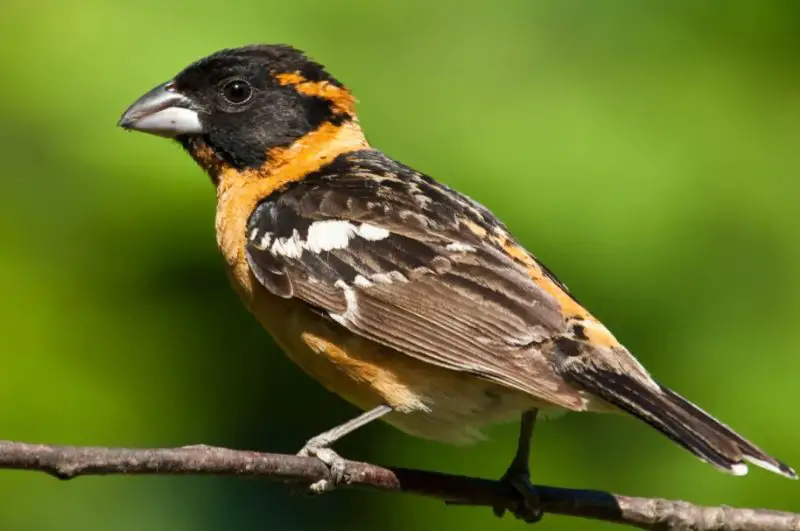
The Black-headed Grosbeak is a medium-sized songbird, approximately 7.5 to 8 inches (19 to 20 cm) long, notable for its striking plumage. Males have a rich orange-cinnamon body with a contrasting black head and wings, accented by white patches on the wings. Females are more muted with brownish and buff streaks but retain the grosbeak’s robust, thick bill. This bird has a melodious, warbling song and various calls used in communication.
In Montana, Black-headed Grosbeaks prefer deciduous woodlands, especially those with dense shrubs or forest edges. They breed in the western parts of the state, often near water sources such as streams and rivers, which support the insect populations they feed on. These birds can also be found in parks and suburban areas with ample tree cover during the breeding season.
Their diet consists primarily of insects during the breeding season, including beetles, caterpillars, and grasshoppers, which provide protein for raising young. In late summer and fall, their diet shifts to seeds and fruits, such as berries and sunflower seeds. This adaptability in diet allows them to thrive in diverse habitats throughout Montana’s warmer months.
Steller’s Jay
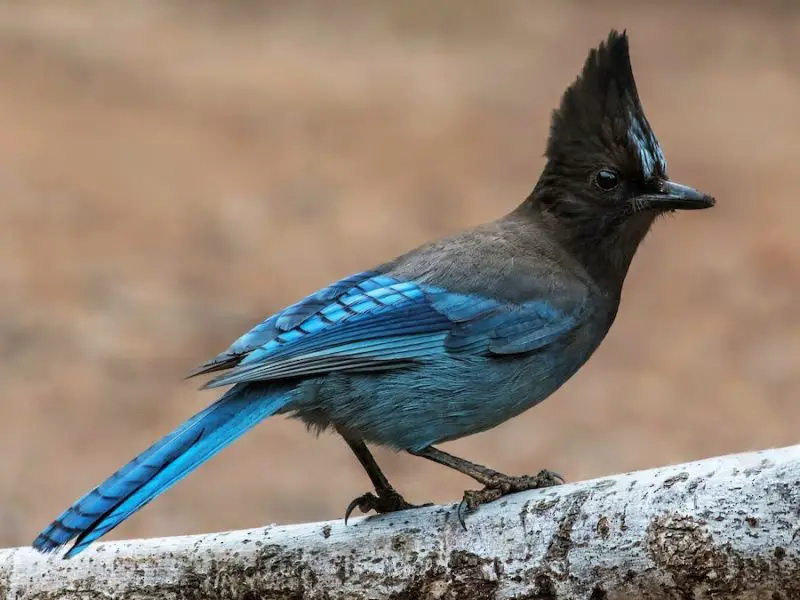
The Steller’s Jay is a striking bird, about 11 to 12 inches (28 to 30 cm) in length, easily recognizable by its vivid blue body and contrasting black head and crest. It has bright blue wings and tail feathers, with a prominent crest on its head that can be raised or lowered. The Steller’s Jay is noisy and bold, often heard before seen with its harsh, rasping calls and varied vocalizations.
In Montana, Steller’s Jays are common in coniferous forests, particularly in mountainous regions. They prefer pine and spruce forests but are also adaptable to mixed woodlands and even urban parks with large trees. These birds are year-round residents in much of western Montana, thriving in areas with dense tree cover and abundant food.
Their omnivorous diet includes seeds, nuts, fruits, insects, and occasionally eggs or nestlings of other birds. Steller’s Jays are known to cache food for later use, storing nuts and seeds in bark crevices or on the ground. Their intelligence and adaptability help them exploit a wide variety of food sources throughout the year.
Black-crowned Night-Heron
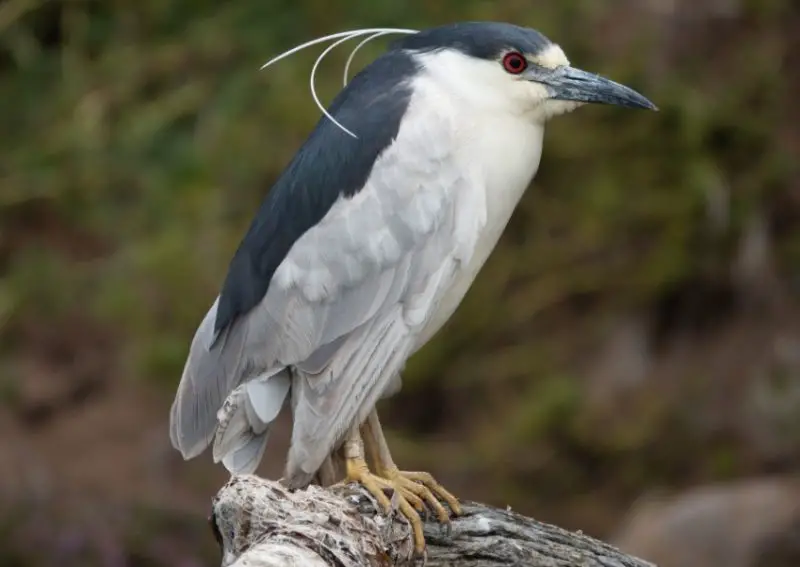
The Black-crowned Night-Heron is a medium-sized heron, about 23 to 28 inches (58 to 70 cm) in length, distinguished by its stocky build and striking black crown and back contrasted with a pale gray body and white underparts. It has red eyes and short yellow legs, with a relatively short neck compared to other herons. This species is primarily nocturnal or crepuscular, often active at dawn and dusk.
In Montana, Black-crowned Night-Herons inhabit wetlands, marshes, lakeshores, and slow-moving rivers, where they nest in dense colonies in trees or shrubs near water. They are more commonly seen in the southern and western parts of the state during the breeding season but may disperse widely after nesting.
Their diet consists mainly of fish, amphibians, crustaceans, insects, and small mammals. Black-crowned Night-Herons hunt by standing still at water edges or slowly stalking prey in shallow water, using their sharp bill to catch prey quickly. Their nocturnal feeding habits help reduce competition with other herons and waterbirds.
Snow Bunting
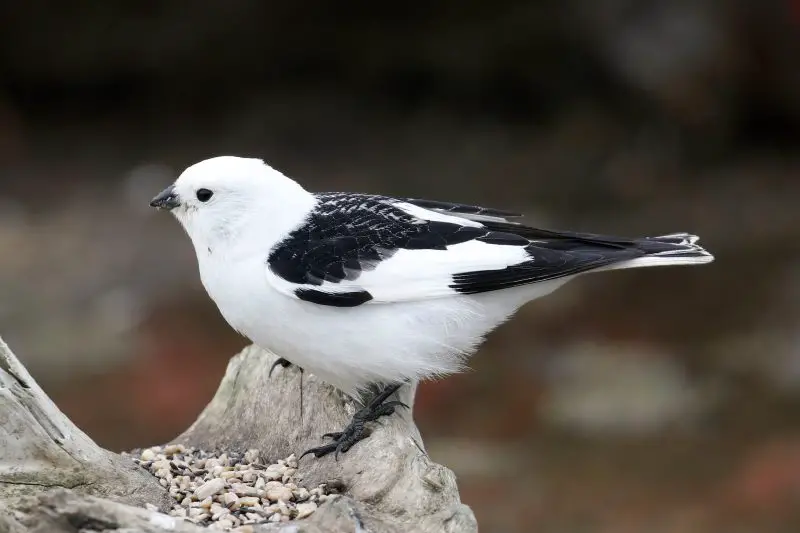
The Snow Bunting is a small, hardy bird about 6 to 7 inches (15 to 18 cm) long, easily identified by its white plumage with contrasting black on the wings and back during the breeding season. In winter, its plumage becomes duller with more brownish tones. It has a stout body and short tail, adapted for cold climates. The Snow Bunting is one of the few birds that thrive in harsh Arctic and sub-Arctic environments.
In Montana, Snow Buntings are primarily winter visitors, often found in open fields, farmlands, and along roadsides. They prefer open, snowy or barren landscapes during winter and migrate north to tundra and alpine regions to breed. Their presence in Montana usually signals cold weather and open habitat availability.
Their diet consists mainly of seeds and grains, especially from grasses and weeds. Insects are also eaten during the breeding season to provide extra protein for growing chicks. Snow Buntings forage on the ground in flocks, using their strong legs and feet to navigate snowy or rocky environments.
Black-bellied Plover
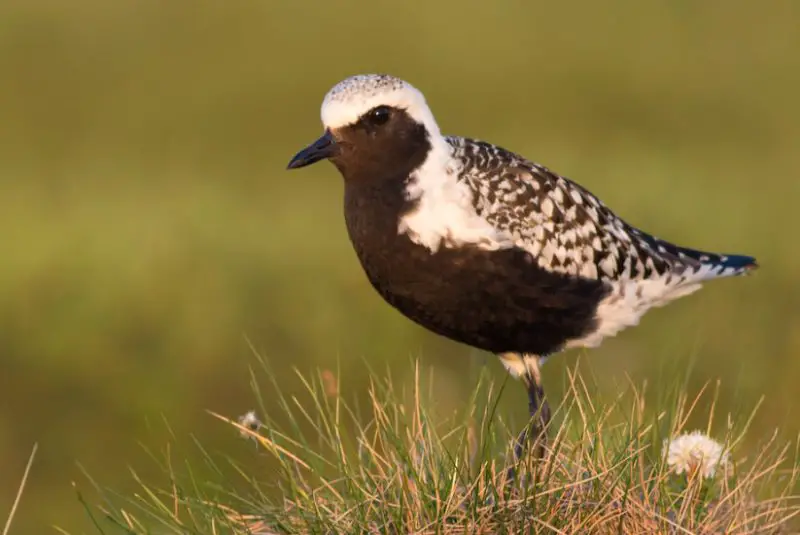
The Black-bellied Plover is a large shorebird, measuring about 11 to 13 inches (28 to 33 cm) in length, known for its striking black and white breeding plumage. During the breeding season, adults have a black face, throat, chest, and belly, with white on the back and wings. In non-breeding plumage, they appear mottled gray and white. They have a robust body, long legs, and a short, thick bill.
In Montana, Black-bellied Plovers are primarily seen during migration in wetland areas, mudflats, and shorelines of lakes and rivers. They stop in the state during their long migratory journeys between Arctic breeding grounds and coastal wintering areas. These birds prefer open, flat, and wet habitats where they can forage for invertebrates.
Their diet consists mainly of insects, marine worms, mollusks, crustaceans, and other small invertebrates found in mudflats and shallow waters. They forage by sight, picking prey from the surface or probing shallow water with their bills. The Black-bellied Plover’s adaptability to various wetland habitats helps it successfully navigate long migrations through Montana.
Black-billed Cuckoo
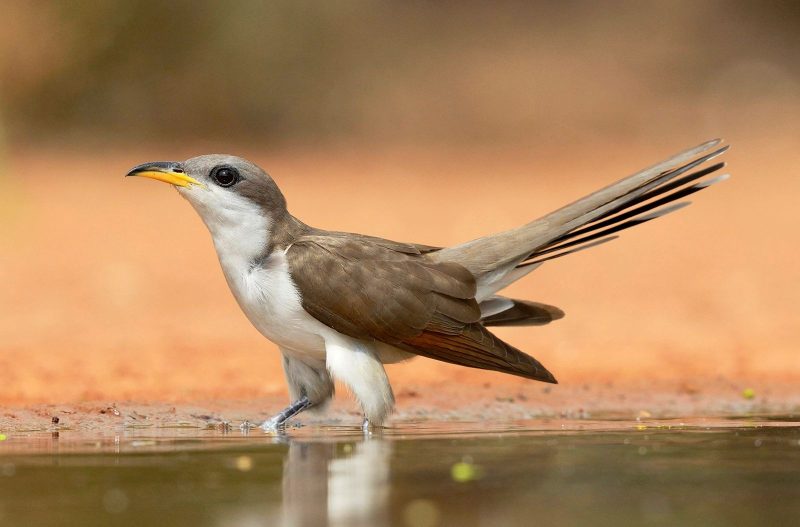
The Black-billed Cuckoo is a medium-sized bird about 12 inches (30 cm) long, with a slender body and long tail. It is mostly brownish-gray on the back with a pale underbelly and has distinctive black bars on its tail feathers. Its most notable feature is its black bill, which distinguishes it from the Yellow-billed Cuckoo. This bird has a soft, low call that is often heard in dense woodlands.
In Montana, Black-billed Cuckoos inhabit deciduous and mixed woodlands, especially those near water or wetlands. They are usually found in dense thickets, forest edges, and shrubby areas during their breeding season in summer. This species is more common in the eastern and southern parts of Montana and is a migratory visitor.
The Black-billed Cuckoo primarily feeds on large insects such as caterpillars, cicadas, grasshoppers, and beetles. It is one of the few birds that will eat hairy or toxic caterpillars, which many other birds avoid. This feeding specialization allows the cuckoo to exploit an abundant food resource during the summer months.
Black-throated Gray Warbler
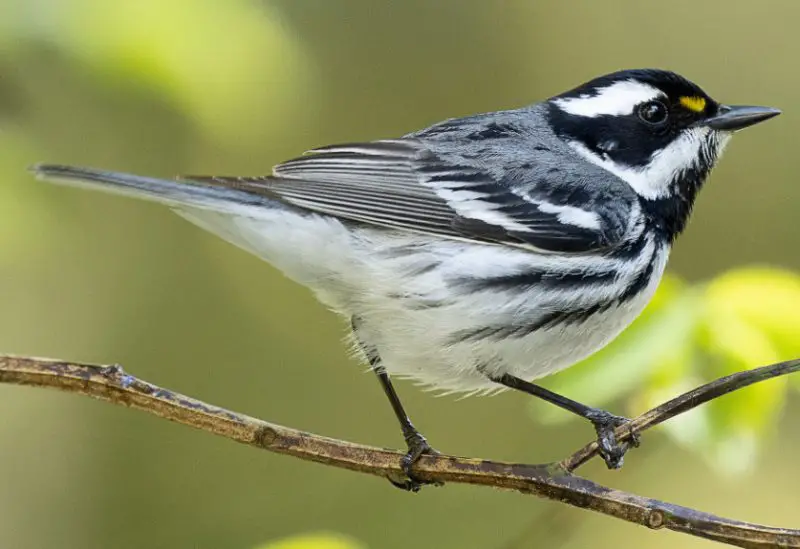
The Black-throated Gray Warbler is a small songbird, about 4.3 to 5 inches (11 to 13 cm) long, easily recognized by its striking black, white, and gray plumage. Males display a black throat and face mask contrasted with white wing bars and a gray back, while females appear somewhat duller but maintain the same pattern. Their sharp, high-pitched song and call notes are often heard in their preferred habitats.
In Montana, this warbler inhabits dry, open woodlands, especially ponderosa pine forests and mixed coniferous habitats, mostly in the western and southwestern parts of the state. They are often seen foraging high in tree canopies or along edges where sunlight penetrates. Their breeding range extends across western North America, and Montana is part of their northern range.
Their diet primarily consists of insects and spiders, which they glean from leaves and bark while actively flitting through the trees. During migration, they may also consume small amounts of fruit and berries. The Black-throated Gray Warbler’s preference for dry forests with open understory makes it a distinctive species among Montana’s woodland birds.
Black-backed Woodpecker
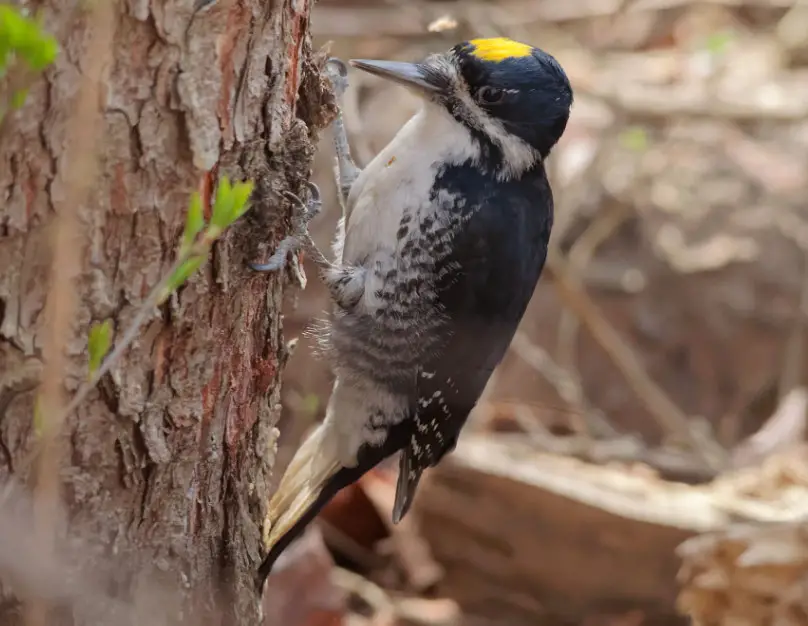
The Black-backed Woodpecker is a medium-sized woodpecker, roughly 9 to 10 inches (23 to 25 cm) long, notable for its striking black back and white underparts. The male has a yellow crown patch, while the female’s crown is solid black. Its long, chisel-like bill and strong legs make it well adapted to pecking into dead or dying trees. Its drumming and sharp calls are common in forested habitats.
In Montana, Black-backed Woodpeckers prefer burned or dead coniferous forests, especially areas recovering from wildfires where bark beetles are abundant. They are mostly found in the northern and western regions of the state. This bird’s specialized habitat choice links it closely to forest disturbance cycles, making it an indicator species for post-fire ecosystems.
Their diet mainly consists of wood-boring beetle larvae and other insects found beneath tree bark. They expertly excavate deep into wood to reach these insects, which form the bulk of their diet. Occasionally, they will consume fruits and seeds, especially in the winter when insect availability is lower. Their dependence on deadwood habitats makes them unique among Montana’s woodpecker species.
Black-legged Kittiwake

The Black-legged Kittiwake is a medium-sized gull, about 15 to 17 inches (38 to 43 cm) in length, easily identified by its white body, gray wings with black tips, and black legs and feet. It has a slender bill and yellow eyes. During the breeding season, adults develop a black “W” pattern on their wings, which fades in winter plumage. Their loud, harsh calls are often heard in coastal breeding colonies.
While primarily a coastal bird, Black-legged Kittiwakes are occasional visitors to Montana during migration or as vagrants, often seen around large lakes or reservoirs. They prefer marine environments but may be found inland near water bodies during the non-breeding season. Montana’s interior habitats are not typical for this species, so sightings are relatively rare.
Their diet consists mainly of small fish, plankton, and marine invertebrates caught by surface dipping or shallow dives. They forage over open water, often following fishing boats or feeding flocks of other seabirds. The Black-legged Kittiwake’s life history is closely tied to oceanic ecosystems, making their appearance in Montana noteworthy.
Black-necked Stilt

The Black-necked Stilt is a striking shorebird about 13 to 16 inches (33 to 41 cm) long, famous for its long, thin, pink legs and stark black-and-white plumage. The head, neck, and back are black, contrasting sharply with its white underparts. Its long, slender bill is slightly upturned, adapted for probing mudflats and shallow water. Stilts are known for their graceful wading and quick movements.
In Montana, Black-necked Stilts are most commonly found in shallow wetlands, alkali flats, and mudflats during migration and summer breeding. They breed in the western parts of the state, favoring marshes and ponds with exposed mud for foraging. Their presence depends heavily on suitable wetland habitats with minimal disturbance.
Their diet consists of aquatic insects, crustaceans, small fish, and other invertebrates, which they pick from the surface or probe in mud and shallow water. Their long legs allow them to wade into deeper water than many other shorebirds, giving them access to unique feeding niches. The Black-necked Stilt’s elegant appearance and striking colors make it a favorite among birdwatchers.
Black-chinned Hummingbird
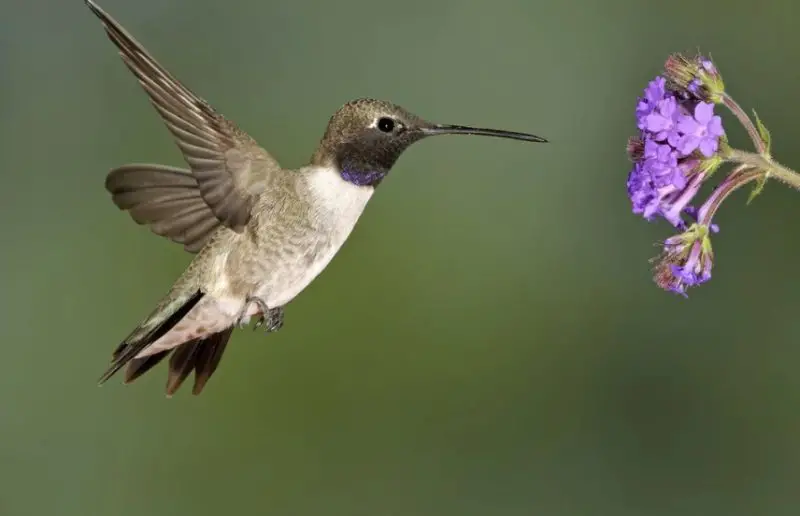
The Black-chinned Hummingbird is a small, agile bird, measuring about 3.25 to 4 inches (8 to 10 cm) in length. Males have a metallic green body with a distinctive black throat bordered by a thin purple band, while females are less colorful with grayish underparts and green backs. Their rapid, humming wingbeats and high-pitched “chip” calls are characteristic sounds of western habitats.
In Montana, Black-chinned Hummingbirds inhabit open woodlands, shrublands, and suburban gardens, especially during the warmer months of late spring and summer. They are mostly found in the western and southwestern parts of the state where flowers and feeders provide nectar. Their range includes riparian areas and dry slopes with abundant flowering plants.
Their diet consists primarily of nectar from flowers, which provides energy for their high metabolism and hovering flight. They also consume small insects and spiders for protein. These hummingbirds are important pollinators, visiting a variety of native and non-native flowering plants. Their fast movements and iridescent plumage make them a captivating sight in Montana’s natural landscapes.
Black Turnstone
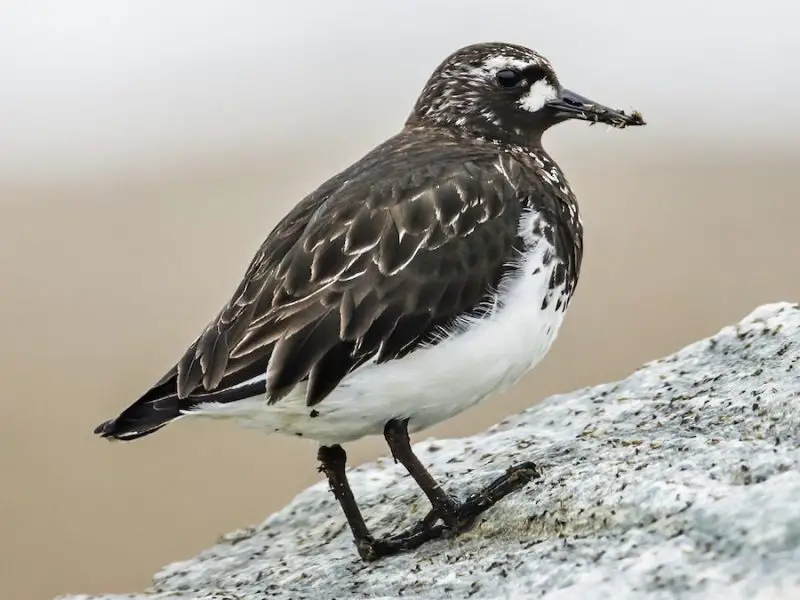
The Black Turnstone is a medium-sized shorebird about 9 to 10 inches (23 to 26 cm) long, recognizable by its dark brown to blackish plumage with white patches on the wings and underparts. It has a sturdy, slightly upturned bill used to flip over stones and debris to find prey. During the breeding season, its plumage is darker, while winter feathers are more mottled.
Black Turnstones are primarily coastal birds, but in Montana, they may appear as rare visitors or migrants near large lakes or river mouths during migration seasons. They favor rocky shorelines, tidal flats, and beaches along the Pacific coast, and Montana sightings are uncommon and noteworthy.
Their diet includes marine invertebrates such as crustaceans, mollusks, and insects, which they find by flipping over stones and debris along shorelines. This foraging behavior gives them their name. Their ability to exploit these specialized habitats along rocky coasts contrasts with the more common shorebird species found in Montana.

